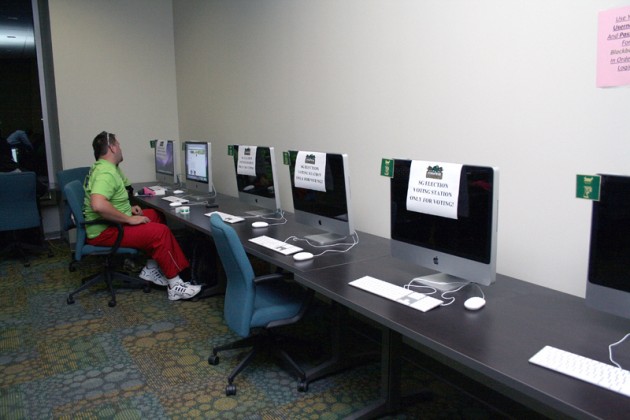On-campus voting falls short

SG elections were haphazardly carried out on campus Monday. What was marketed as “stampeding the polls” could best be described as an unprepared stumbling of less-than-informed students to computer labs.
Students may vote on campus through Thursday at any of 11 polling locations, or off-campus using Blackboard.
Eight of the polling locations are situated in computer labs across campus. No signage was posted inside buildings to indicate the location of polls, with the exception of a small sign on the Marshall Student Center computer lab.
“We don’t want to be involved in defacing anything,” said Michael van Hoek, supervisor of elections. “We have to remember those computer labs are primarily academic areas, and we don’t want to interfere with the academic process.”
He said the Election Rules Commission felt sufficient information on poll locations had been provided to the USF community.
Upon visiting poll locations at the Education, Sociology and Engineering buildings, Oracle reporters found nothing more than a few handbills and tiny “I voted” stickers. When questioned, the staff at each of these locations gave superficial and sometimes inaccurate information. At one location, a staff member wasn’t informed that the computer lab was a polling location, and told reporters she thought voting was only conducted at the Marshall Student Center.
The investigation of the Marshall Student Center computer lab proved more promising. Two volunteer poll workers were on hand to answer questions and address any problems.
One volunteer, Matt Miller, a junior majoring in religious studies, said, “There are supposed to be one or two volunteers at any given station.”
That would certainly be the ideal situation. However, the ideal situation was already squandered by the dearth of information and lacking visibility of polling locations.
When asked to describe voter turnout, Miller said roughly 30 people voted in the three hours he worked at the Marshall Student Center computer lab.
The SG Election Rules Commission was allocated $23,777.92 for 2008-2009 election, according to the annual budget request. Payroll for seven supervisors accounts for $15,900 of that figure. It is hard to reason why a single student election would need so much supervision. It is perhaps even harder to understand why — with such an overabundance of supervision — the election was not carried out more professionally on campus.
Much of the hassle of on-campus polling could have been avoided altogether if students who lived on campus had been allowed to vote online.
Van Hoek said the block was precipitated by stories about candidates hosting late-night parties with laptops to get people to vote for them — but what began with good intentions may have had unnecessary consequences for voter turnout.
There is an obvious problem with any inequity in voter accessibility.
A voting system that allows students who live off campus to easily vote online yet requires residents to hunt for largely unadvertised polling locations should’ve been rejected on principle.
SG elections have had a historically low voter turnout. Last year, only 5,165 students voted — about 13 percent of eligible voters. Restricting access to online voting and situating poll locations at low-traffic areas does nothing more than discourage students from participating.






